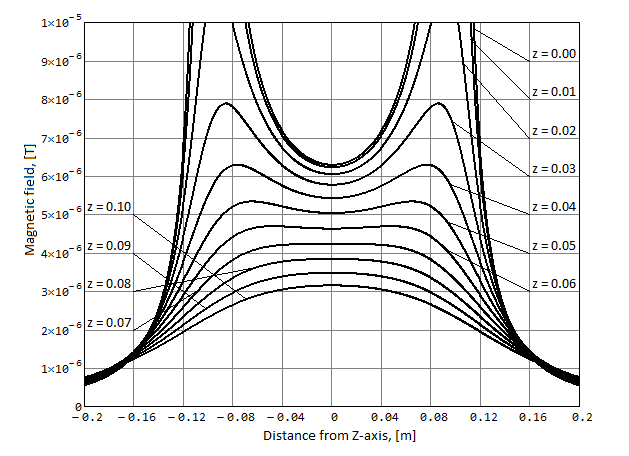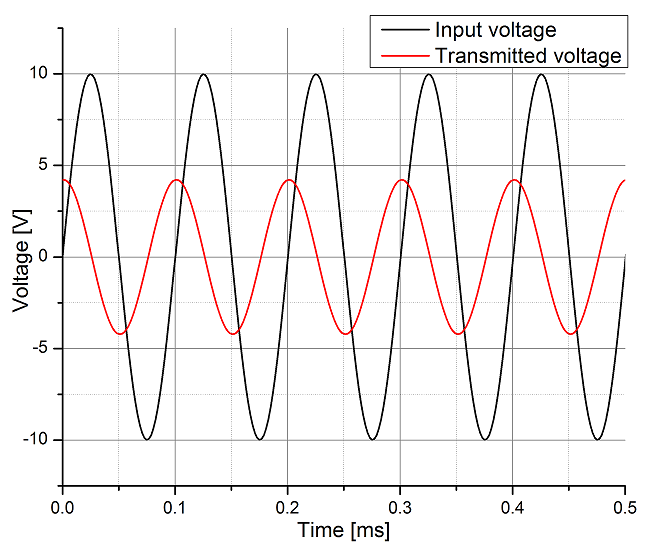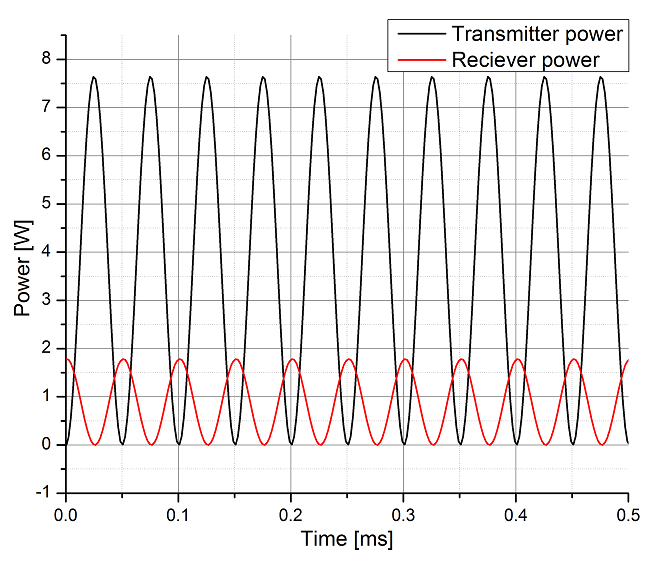Introduction
I think that many of the readers have seen at least one video on popular video services, where electricity is transmitted through empty space using inductive coils.
In this article, we want to address the fundamentals of the process of wireless energy transmission using a magnetic field. Starting with consideration of the simplest inductive coil, and calculating its inductance, we will gradually move on to the theory of electrical circuits, in the framework of which the method of
transmitting maximum power will be shown and justified under other equal conditions. So, let's begin.
Magnetic field of a single coil with current
Consider the magnetic field of a single coil with a current. Find the magnetic field of the coil at any point in space. Why is such a review necessary? Because in almost all books, at least in those that the author of the article was able to find, the solution to this problem is limited to finding only one component of the magnetic field and only along the axis of the coil -
, while we will find the law for the magnetic field in the whole space.
 Illustration to the law of Bio-Savard-Laplace
Illustration to the law of Bio-Savard-LaplaceTo find the magnetic field, we use the law of Bio-Savart-Laplace (see
Wikipedia - the Law of Bio-Savard-Laplace ). The figure shows that the center of the coordinate system
coincides with the center of the coil. The contour of the circle of the coil is indicated as
, and the radius of the circle - as
. During the coil current flows
.
- is a variable-radius-vector from the origin to an arbitrary point of the coil.
Is the radius vector to the observation point. We also need a polar angle.
- the angle between the radius vector
and axis
. The distance from the axis of the turn to the observation point is denoted by
. And finally
- elementary increment of the radius-vector
.
According to the law of Bio-Savard-Laplace, the circuit element with current
creates an elementary contribution to the magnetic field, which is given by the formula
Now we’ll dwell on the variables and expressions included in the formula. Given the axial symmetry of the problem, we can write
[\ mathrm {d} \ vec {r} \ times (\ vec {r} _0- \ vec {r})] = \ begin {vmatrix} \ vec {e} _x & \ vec {e} _y & \ vec { e} _z \\ -a \ sin {\ varphi} \, \ mathrm {d} \ varphi & a \ cos {\ varphi} \, \ mathrm {d} \ varphi & 0 \\ \ rho -a \ cos {\ varphi } & -a \ sin {\ varphi} & z \ end {vmatrix} = (az \ cos {\ varphi}, az \ sin {\ varphi}, a ^ 2 -a \ rho \ cos {\ varphi}) \ , \ mathrm {d} \ varphi
In order to find the resultant magnetic field, it is necessary to integrate over the whole loop contour, i.e.
After the substitution of all expressions and some identical transformations, we obtain expressions for the axial and radial components of the magnetic field, respectively
To find the absolute value of the magnetic field, it is necessary to sum up the components according to the Pythagorean theorem
.
Let us demonstrate the solution obtained using the example of a radius coil
(m) and
(BUT).
 The amplitude of the axial component of the magnetic field
The amplitude of the axial component of the magnetic field The amplitude of the radial component of the magnetic field
The amplitude of the radial component of the magnetic field Absolute magnetic field amplitude
Absolute magnetic field amplitudeNote that for a coil of arbitrary shape, at large distances
i.e. much larger than the characteristic size of the coil, the behavior of the magnetic field will tend to the solution found.
Hint...For such calculations and graphing is convenient to use MathCad 15
Inductor. Magnetically coupled coils
Now that we know the solution for the magnetic field of a single turn, we can find the inductance of the coil, consisting of
turns. By definition, inductance is the coefficient of proportionality between the current in a coil and the magnetic flux through the cross section area. Here we use the ideal coil model, which is dimensionless in the direction of its axis of symmetry. Of course, in practice this does not happen. However, as approximations, the formulas obtained will be good enough. Although coils are considered dimensionless along
, you must specify a non-zero radius of the wire cross section. Denote it
and example equal
(mm) Otherwise, when integrating the magnetic flux, the integrand will turn to infinity.
 Inductively connected coils
Inductively connected coilsThe figure shows two magnetically coupled coils. Let the first coil have a radius
and contains
turns, and the second -
and
respectively. Then, in order to find the own inductances, it is necessary to calculate the magnetic flux of each coil through its own section.
\ Phi = \ iint_S {\ vec {B} \ cdot \ vec {\, \ mathrm {d} S}} = \ int_0 ^ {2 \ pi} {\ int_0 ^ {a- \ delta} {B_z (\ rho, z) \ rho \, \ mathrm {d} \ rho \, \ mathrm {d} \ varphi} = 2 \ pi \ int_0 ^ {a- \ delta} {B_z (\ rho, z) \ rho \ , \ mathrm {d} \ rho}
Since there are many turns in the coil, we find the quantity called the flux linkage, by multiplying twice the number of turns
By definition, inductance is a coefficient of proportionality
in the formula
. Thus, we obtain the own inductances of the coils
Let the centers of the coils be separated by distance
, lie on the same axis, and their plane of turns is oriented parallel. To find the mutual inductance, it is necessary to calculate the flux linkage formed by one coil through the cross section of another, i.e.
Then the mutual inductance of the coils is given by
As far as the author knows, such integrals can be taken only numerically.
Note that as a rule
and
. Coil coupling coefficient is called magnitude
We investigate the dependence of the coupling coefficient of the coils on the distance. To do this, consider two identical coils with a radius of turns
(m) and the number of turns
. In this case, the inductance of each of the coils will be
(mH).
 Coil coupling ratio of the distance between them
Coil coupling ratio of the distance between themThe schedule will not change if the number of turns in both coils is equally changed, or the radius of both coils is equally changed. The coupling coefficient is conveniently expressed as a percentage. From the graph it is seen that even with the distance between the coils of 1 (mm), the coupling coefficient is less than 100%. The coefficient drops to 10% at a distance of about 60 (mm), and to 1% at 250 (mm).
Wireless power transmission
So, we know inductance and coupling coefficient. Now let us use the theory of electrical circuits of alternating current to find the optimal parameters at which the transmitted power would be maximum. To understand this paragraph, the reader must be familiar with the concept of electrical impedance, as well as Kirchhoff's laws and Ohm's law. As is known from the theory of circuits, two inductively coupled coils form an air transformer. For the analysis of transformers convenient T-shaped equivalent circuit.
 Air transformer and its equivalent circuit
Air transformer and its equivalent circuitThe transmitting coil on the left will be called the "trasmitter", and the receiving coil on the right will be called the "receiver". Between coils coupling coefficient
. On the side of the receiver is the consumer represented by the load
. The load can generally be complex. Input voltage on the transmitter side
and input current -
. The voltage transmitted to the receiver -
and current transmitted
. The full impedance on the transmitter side is denoted as
, and the full impedance on the side of the receiver
.
It is assumed that a sinusoidal voltage is applied to the input of the circuit.
.
Denote
- resistance and inductance of the coils (two own and one mutual), respectively. Then, according to transformer theory
On the other hand, according to our designations
Where
- total resistances on the side of the transmitter and receiver, respectively, and
- full
reactive resistances.
Communication impedance is
.
Find the input current of the circuit
where is the sign
denotes a parallel connection of resistances. Then the voltage transmitted to the receiver
And induced current
We can find the integrated power transmitted to the receiver
Thus, we have an expression for the complex power
Expression for
active power component
Expression for
reactive power components
In most practical tasks, the maximum active power is required, therefore
Either that same
For convenience, we introduce the function
and examine it for extremes
Where do we get a system of two equations
This system has five solutions, two of which are nonphysical, since they lead to imaginary values of quantities that are supposed to be valid. Three other
physical solutions are given below, together with the corresponding power formulas.
Solution 1
Power
Solution 2 and 3
Power for solutions 2 and 3
Solution 2 and 3 should be used when the coupling reactance is large enough.
When this is not the case, you need to use solution 1. Most often in real situations
will be small, so consider solution 1 in some detail.
Solution 1:
. And the corresponding active power is given by the formula
It can be seen from the power formula that the power depends on the reactance of the connection
and therefore from the transmission frequency
, and from the geometry of the relative position of the coils, which is taken into account by the coupling coefficient
.
As attentive readers noticed, addiction
- nonlinear. Function
reaches a maximum at
.
 Power formula research on extremes
Power formula research on extremesMaximum active power at
equals
Thus, the above formula represents the
absolute theoretical limit of the transmitted active power under any conditions. For reactive power transmitted to the receiver, we have
Numerical simulation
You can demonstrate the work of the above theory by running the SPICE simulation of the model of our device from two coupled coils.
 SPICE model of two inductively coupled coils
SPICE model of two inductively coupled coilsSimulation performed for coupling coefficient
%, which corresponds to 25 cm removal between the coils. The parameters of the coils are the same as in the previous paragraph, adopted for plotting
.
It turns out that the reactances of each of the coils must be compensated for by capacitors.
and
. That is, adjust each of the circuits (transmitting and receiving) to resonance at a given frequency. If we assume that the load value is real, then the values of the containers can be found from the formulas
Below are two graphs for the transmitted voltage and transmitted power over time at a frequency
(kHz).
 Transmitted voltage
Transmitted voltage Transmitted power
Transmitted powerThe figures show that at a distance of 25 (cm) the transmitted voltage turned out to be approximately 2.5 less than the input, and the transmitted peak power was approximately 4 times less than the power consumed from the input,
which is consistent with the formulas obtained .
In conclusion, we describe what measures can be taken to increase the transmitted power:
- increase the number of turns in the coils
- increase the turn radius
- increase transmission frequency
- reduce the distance between the coils
- insert magnetic core belonging to both coils (closed or open)
- enter an open magnetic core belonging only to the receiver coil
Perhaps writing this article imposes an obligation on the author to make and test such a system of two coils in the laboratory, but this is a completely different story. Thank you for attention.
Literature
- Sivukhin, D.V. “General course of physics. Vol. 3: Electricity and magnetism. "(1990).
- Bessonov, Lev Alekseevich. Theoretical foundations of electrical engineering. Electromagnetic field. Limited Liability Company Publishing Yurayte, 2012.
- Lavrentyev, M. A., and B. V. Shabbat. "The theory of functions of a complex variable." (1972).